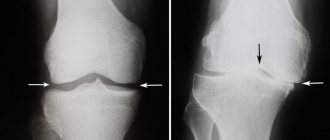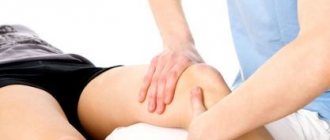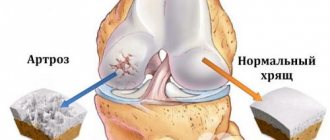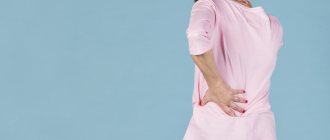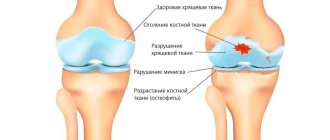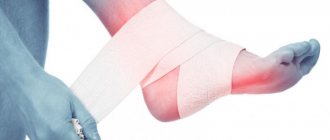Pain in the shoulder joints is a common reason for patients to seek treatment. They arise for several reasons, and if left untreated, they lead to limited abduction in the shoulder joints, after which the person cannot raise his arm above his head. The most common cause of this pain is arthrosis of the shoulder joint. Modern treatment methods make it possible to slow down or even stop the development of degenerative joint diseases and maintain vital activity in patients.
General information
Cartilage tissue is a smooth layer between the adjacent areas of bones. It ensures their easy sliding relative to each other, ensuring free and painless operation of the joint. Excessive stress, inflammation or injury can trigger a degenerative process that gradually spreads over the entire surface.
As a result, the smoothness of the articular surfaces is disrupted, and movements begin to cause pain. At the same time, bone growths begin to appear along the edges of the joint, replacing the affected cartilage. As the degenerative process progresses, it involves not only bones, but also surrounding tissues. The limb becomes deformed, the muscles spasm, and the ligaments become weak and lose elasticity. Without treatment, a person loses the ability to move his arm.
Make an appointment
Traditional methods
The following techniques are available for use at home:
- A heaping tablespoon of oatmeal is poured into two glasses of water and put on fire to boil for 10 minutes. The resulting mass is cooled to a temperature that is tolerable for the skin and applied to a piece of gauze. This compress is applied to the sore joint for one hour. This method will help relieve pain symptoms.
- A salt compress is also good for inflammation. A salt solution is prepared by dissolving 50 grams of salt in 500 grams of water. Gauze is dipped into the resulting solution for three hours, after soaking it is wrung out, the fabric is heated and applied to the affected joint.
- A tincture of elecampane is well suited for rubbing. When preparing 100 grams of dry roots of the plant, infuse it with a glass of strong vodka and apply it to the affected area up to 5 times a day every day. This tincture stimulates blood circulation and relieves pain.
- Healing decoction. In a metal bowl, mix half a celery root, 3 parsley roots, and a little black pepper. The plant mixture is poured into three glasses of water and boiled under the lid for 10 minutes. The resulting decoction is used orally before each meal for up to two weeks.
Traditional methods cannot completely replace drug treatment, but are an additional means of combating pathology.
Causes
Unlike the knee, ankle and hip joints, the shoulder does not experience significant stress when walking, which is why this form of arthrosis occurs much less frequently. Pathology can be caused by:
- regular excessive physical activity: heavy lifting, professional sports, vibration;
- congenital pathologies of the structure of the shoulder joint and adjacent structures;
- rheumatoid arthritis, systemic lupus erythematosus and other autoimmune diseases;
- congenital weakness of connective tissue, accompanied by joint hypermobility;
- injuries: dislocations, sprains and ruptures of ligaments, intra-articular bone fractures;
- hormonal changes and disruptions (including pregnancy, menopause);
- inflammatory diseases of the joint and periarticular structures (arthritis, bursitis, etc.);
- metabolic disorders, including gout, diabetes.
Heredity plays an important role in predisposition to arthrosis.
What to do for various types of pain
The shoulder joint has a complex structure; surrounding muscles, tendons, and ligaments take part in its work. When various structures are affected, shoulder pain appears, having different localization and character. To save the patient from suffering, you need to find out the cause of shoulder pain. This can only be done by an orthopedic traumatologist or rheumatologist. The patient must correctly describe his condition, tell where it hurts, when the pain appeared and what he associates with its occurrence. So, the pain can vary.
Shoulder pain due to coronavirus and other viral diseases
Coronavirus infection is absolutely unique, as it manifests itself differently in each patient. In this case, heredity obviously plays a big role. For example, if a person has close relatives suffering from rheumatoid arthritis, then the risk of developing this disease after suffering from Covid-19 increases many times over.
Moreover, the disease in many patients begins with damage not to small, but to large joints, including the shoulder. During the course of the disease, some patients may also experience symptoms of acute arthritis with severe pain in the shoulder joint. After recovery they completely disappear.
Many viral infections can be accompanied by acute arthritis (influenza, rubella, infectious hepatitis, etc.). As a rule, they have a benign course and end with complete recovery. But it is better to treat them under the supervision of a doctor.
Shoulder pain when moving your arm
When the periarticular tendons and ligaments are damaged, acute short-term pain in the shoulder appears during movement. After this, even at rest, some people are still bothered by aching waves of pain. The reasons for their appearance can be different from acute injuries and microtrauma to unnoticed chronic arthritis and arthrosis. To eliminate such pains, you need to find out their nature. Only a doctor can do this.
Pain in left or right shoulder
The causes of shoulder pain on the right or left can be different. One shoulder can hurt during inflammatory processes, after injuries, in old age against the background of degenerative-dystrophic disorders in the tissues. In acute arthritis, pain in the shoulder joint is intense and constant, accompanied by swelling and redness of the tissues, and an increase in body temperature. After an injury, severe bursting pain in the shoulder often appears, associated with intra-articular hemorrhage (hemarthrosis). When ligaments or tendons rupture, pain is combined with impaired movement.
Sometimes acute pain in the left shoulder is a symptom of myocardial infarction or cervicothoracic osteochondrosis. It can be difficult to distinguish one from the other, since osteochondrosis pain is practically indistinguishable from infarction pain. Such patients are hospitalized and in the hospital they figure out what exactly happened.
The cause of pain in the right shoulder may be acute cholecystitis. It radiates to the right shoulder girdle along the phrenic nerve.
The doctor’s task is to identify the causes of the painful symptom and provide pain relief therapy. This can only be done in a clinic!
Shoulder pain when inhaling
When a tendon ruptures, dislocates, or fractures, taking a deep breath increases the pain. The victims require emergency surgical care.
But pain in the shoulder when inhaling can also be a sign of a serious illness of the internal organs. Thus, with myocardial infarction or pleurisy, pain waves often radiate to the shoulder and intensify with inhalation. These patients also require emergency care and hospitalization.
If there is pain when inhaling, you need to call an ambulance: this patient may need to be hospitalized.
Shoulder pain after injury - fracture or dislocation
Injuries are always painful. But sometimes the victim cannot assess the severity of his condition and does not immediately seek medical help. This significantly complicates the condition and often leads to the appearance of chronic glenohumeral pain syndrome. Main symptoms of traumatic injuries:
- An intra-articular fracture of the humeral head is usually combined with a fracture of its neck.
The most common cause is a fall on an outstretched arm. Symptoms: severe pain in the shoulder girdle, crunching, deformation of the injured area and limitation of movements. Emergency hospitalization required. - Dislocation
- often combined with rupture of the joint capsule and tendon-ligamentous apparatus, so there is a risk of dislocation becoming habitual, recurring with minor injuries. Since the shoulder joint is very mobile, dislocations often occur due to falls or impacts. Sometimes a person gets dislocated while lifting a heavy object. Symptoms: swelling of the periarticular tissues, inability to move the arm, pain in the arm from the shoulder. It is necessary to reduce the dislocation followed by rehabilitation to prevent habitual dislocation. - Bruise
- even a minor bruise causes damage to soft tissue cells - synovium, ligaments, tendons and muscles. An aseptic inflammatory process develops. During a bruise, acute pain appears in the shoulder, which after a while becomes aching. Then the aching pain in the shoulder goes away, but there is a risk of acute inflammation becoming chronic with a gradual loss of joint function. Therefore, after bruises it is necessary to carry out rehabilitation measures. - Ligament rupture
is the most common injury, which initially occurs acutely, with severe pain, tissue swelling and impaired movement. Then the symptoms decrease or disappear, and after a while slowly increasing pain and limitation of movements appear. Therefore, it is very important to carry out proper adequate treatment of such injuries with subsequent rehabilitation.
Crunching in joints - when to worry
Joint pain at rest
Shoulder and arm pain
Shoulder pain radiating to the arm may be due to:
- acute arthritis or exacerbation of chronic arthritis with swelling of tissues compressing nerve trunks; pain in the shoulder is acute and can radiate throughout the arm to the forearm, hand and fingers; Depending on the type of arthritis, it is treated by a surgeon or rheumatologist;
- humeroscapular periarthritis - inflammation of periarticular (surrounding the joint) tissues - muscles, tendons, ligaments - this is the most common cause of the development of chronic pain syndrome; pain in the arm from the shoulder is aching, debilitating, often appears at night or after any physical activity; tissue swelling can lead to compression of nerves and irradiation of painful waves in the forearm and hand; The cause of such pain in the shoulder can be both purely inflammatory processes and the consequences of injuries, ruptures of tendons and ligaments; long-term speech and rehabilitation are required;
- cervical osteochondrosis - it can cause pinching of the spinal nerve roots; pinching at the C5 – C6 level leads to severe pain in the shoulder with irradiation to the right or left forearm and hand; requires treatment from a neurologist;
- coronary heart disease with attacks of angina or myocardial infarction; a sharp spasm of the coronary arteries (vessels supplying the heart with blood) causes severe pain in the heart, often radiating to the left shoulder girdle, as well as pain in the arm from the shoulder; in order to remove the spasm, you need to take a nitroglycerin tablet under the tongue; if there is no effect, call an ambulance.
Neck and shoulder pain
Often strong pain waves occur simultaneously in the shoulder and neck, so it is difficult for the patient to figure out where they begin. Sometimes the pain starts in one shoulder and radiates to the neck. The cause of such shoulder pain is shoulder arthritis or glenohumeral hyperarthritis with tissue swelling and compression of the spinal nerves. In other cases, the pain begins in the neck and shoulders on both sides. This is a sign of cervical osteochondrosis with pinching of the spinal nerve roots and radicular pain. To remove pain and help the patient, you need to establish the correct diagnosis and prescribe adequate treatment.
Shoulder pain radiating to the scapula, elbow, collarbone, back, head
Many patients complain of such symptoms. They are characteristic of cervicothoracic osteochondrosis with entrapment of the spinal nerve roots at the level of 5 - 7 cervical vertebrae (C5 - C7) and 1 -2 thoracic vertebrae (Th 1 - Th2). First, pain appears in the back and side of the neck, then severe pain in the shoulder. The pain can spread from the shoulder to the elbow, move to the collarbone, radiate to the frontal region of the head and down to the scapula area.
If the motor fibers of the roots are damaged, paresis or paralysis of the upper limb may occur. Treatment by a neurologist will help.
Shoulder pain when flexing and extending
Pain that increases with flexion and extension of the shoulder joint is a symptom of damage to nearby muscle tendons. These are 4 tendons that are part of the rotator cuff and the biceps tendon. When they become inflamed (tendonitis), movements in the shoulder joint become impaired and become painful. Damage to the biceps muscle (biceps) also manifests itself in severe pain when bending the elbow. Tendinitis can be the result of injury or inflammation in the joints. The treatment is carried out by an orthopedist-traumatologist; the pain can be removed after high-quality rehabilitation.
Shoulder pain at night
Night pain in the shoulder is characteristic of inflammatory processes in the shoulder joint and periarticular tissues. During sleep, the body warms up, blood vessels dilate, the liquid part of the blood leaks into the surrounding tissues, forming swelling and squeezing nerve endings. To get rid of night pain in the shoulder joint, you need to treat the underlying disease.
Shoulder pain after exercise
Training accompanied by severe pain is unacceptable. They contribute to the exacerbation of the pathological process and its chronicity. Severe pain in the shoulder during exercise should be a reason to stop training. You can resume classes only after it has stopped. The load should be reduced in this case.
Shoulder pain with swelling
These signs are characteristic of acute arthritis and exacerbations of chronic arthritis. In addition, shoulder pain and tissue swelling appear after injury. In both cases, urgent assistance from a specialist is required.
This cannot be left to chance: a slow and imperceptible decrease in joint function with the formation of pain is possible.
Pain in the shoulder joint due to inflammatory processes can be eliminated
Shoulder pain and numbness
The causes of shoulder pain in combination with numbness are pinching of the spinal nerve roots of the cervical spine due to osteochondrosis and herniated intervertebral discs. Sometimes this is combined with movement disorders - paresis and paralysis. A similar symptom can appear with plexitis - inflammation of the nerves of the brachial plexus. The pain can be very severe, so you should not delay your visit to a neurologist.
Pain when raising your arm
This symptom is characteristic of pinched tendons of the rotator cuff and biceps muscles between the acromion and the head of the humerus. Severe pain appears in the shoulder when raising the arm up to a level below the shoulder joint. An orthopedic traumatologist treats injuries.
Degrees
Doctors distinguish 3 degrees of deforming arthrosis of the shoulder joint, determining its symptoms and the choice of treatment tactics:
- Grade 1 is characterized by minimal manifestations: pain occurs only during intense or prolonged exercise and quickly goes away after rest, and x-rays reveal subchondral sclerosis of the articular surfaces;
- with arthrosis of the 2nd degree, the pain becomes much stronger, the person has to use painkillers to feel better; The x-ray shows a pronounced narrowing of the joint space, extensive areas of cartilage destruction, as well as bone growths (osteophytes);
- Stage 3 of the disease is accompanied by constant intense pain, joint mobility is significantly limited, and the image shows complete destruction of cartilage tissue, deformation of bone structures and a large number of osteophytes.
Mechanism of action of intra-articular injections "Noltrex"
To restore the viscosity of synovial fluid, a special artificial endoprosthesis Noltrex with the addition of silver ions has been developed. The gel is injected into the joint cavity in a medical office at intervals several times. The composition is completely biocompatible with tissues and therefore does not cause allergic or other reactions.
By introducing the drug into the joint cavity, the following results can be achieved:
- protect cartilage - the gel covers the synovial membrane and articular surfaces with an even layer, softens mechanical stress and stops further destruction;
- restore the viscosity of the synovial fluid - a drug with viscosity characteristics close to natural normalizes the properties of the joint environment;
- dilute the rubbing surfaces - the product restores the normal viscosity of the synovial fluid, as a result of which the joint spaces widen and friction stops.
Noltrex relieves pain in the shoulder joint for a year and a half
Symptoms
The main symptoms of shoulder arthrosis include:
- pain: occurs due to decreased smoothness of articular surfaces, proliferation of osteophytes and bone deformation; the intensity, duration and nature of the sensations depend on the degree of damage;
- crunch: one of the characteristic symptoms of the disease that appears in the early stages; differs from the physiological one in a coarser tone, and is also often accompanied by pain;
- limitation of mobility: associated with the appearance of pathological growths and particles of destroyed cartilage inside the joint; in the first stages it is represented by slight morning stiffness, which later increases until complete immobility (ankylosis);
- deformation: a change in the contours of first only the joint, and then the arm, occurs in the later stages of the disease and indicates complete destruction of the cartilage and involvement of bones, muscles and ligaments in the pathological process.
The progression of symptoms can occur over years or even decades, but eventually arthrosis of the shoulder joint leads to the inability to move the arm and severe pain.
Diagnostics
Diagnosis of arthrosis of the shoulder joint requires an integrated approach. To accurately make a diagnosis and determine the extent of damage, the doctor uses the following methods:
- interview and history taking: the patient’s complaints are recorded, the circumstances of the occurrence of certain symptoms are determined; It is mandatory to clarify information about previous diseases and injuries, and the presence of joint damage in parents;
- examination: the doctor evaluates the joint visually, determines the range of movements, the area of greatest pain, etc.;
- X-ray and CT: the main diagnostic method that allows you to see the characteristic symptoms of osteoarthritis (narrowing of the joint space, cartilage degeneration, bone growths and deformities);
- Ultrasound: makes it possible to assess the condition of cartilage, bones, ligaments, joint capsule and muscles;
- MRI: allows you to obtain virtual sections of all structures of the affected area;
- laboratory diagnostics: a blood test reveals an active inflammatory process, often accompanying arthrosis;
- arthroscopy: examining the inside of a joint using a camera inserted through a small puncture.
If the disease is secondary in nature, examinations and consultations with narrow specialists on the underlying pathology are mandatory.
Treatment of arthrosis of the shoulder joint
Treatment of arthrosis of the shoulder joint depends on the degree of damage: at stages 1 and 2, the disease can be successfully stopped or slowed down by the correct selection of drugs. In case of extensive destruction, the only way to restore mobility and completely stop pain is surgery - arthroscopy with “cleaning” of the joint.
Drug treatment
Drug treatment for shoulder arthrosis is aimed at reducing symptoms and restoring cartilage tissue. The following groups of drugs are used for this:
- non-steroidal anti-inflammatory drugs (diclofenac, ibuprofen, nimesulide, meloxicam and their derivatives): block inflammatory reactions and reduce pain; are available in the form of tablets, ointments, suppositories and in injection form;
- hormonal agents (corticosteroids): used when NSAIDs are ineffective, have a similar effect; long-acting drugs injected directly into the joint cavity have a good effect;
- antispasmodics, B vitamins: used to reduce muscle spasms that inevitably accompany advanced arthrosis;
- chondroprotectors (chondroitin, glucosamine and their combinations): intended for long-term use, aimed at restoring cartilage tissue;
- drugs that improve microcirculation (nicotinic acid, pentoxifylline and others): indirectly stimulate regeneration processes by improving blood supply to the affected area;
- Enzyme blockers (contrical, gordox): partially slow down the destruction of cartilage tissue.
The selection of specific drugs, their dose, frequency of administration and course duration is carried out only by a doctor! It is important to remember that self-medication can accelerate joint degeneration and cause other side effects.
Physiotherapy
Physiotherapeutic techniques and exercise therapy significantly alleviate the course of the disease and enhance the effect of medications. The following procedures have proven good results:
- magnetic therapy: relieves pain, relieves inflammation, improves microcirculation and stimulates the regeneration of cartilage tissue;
- shock wave therapy: exposure to acoustic waves of a certain frequency helps destroy osteophytes, which facilitates movement in the affected joint;
- electrophoresis, phonophoresis: introduction of medications (painkillers, chondroprotectors) into tissues using electrical impulses or ultrasound; promotes better absorption of drugs;
- massage and physical therapy: dosed loads on the joint and intense manual stimulation stimulate blood circulation in the tissues.
Like medications, physiotherapy, massage and exercise therapy should be prescribed and carried out under the supervision of a specialist. If they are beneficial during a calm period, then exposure against the background of an acute inflammatory process can cause increased pain.
Surgery
The last stage of shoulder arthrosis is accompanied by severe symptoms and requires surgical treatment. Most of the changes that occur as a result of degeneration are irreversible, which is why the only way to restore mobility to a person is endoprosthetics. The affected joint is replaced with a modern prosthesis, which completely takes over its functions. This operation is especially effective in young and middle age, as it allows you to live without pain for years.
Make an appointment
Physiotherapy
Physiotherapeutic treatment, in the absence of contraindications, is widely used for the treatment of arthrosis in combination with other measures. They help enhance the effect of medications, reduce their dosage, and avoid side effects. It can be prescribed from the first days of illness and combined with drug therapy.
The main physiotherapeutic methods used in the treatment of arthrosis are as follows:
- electrophoresis;
- ultrasound;
- magnetic therapy;
- laser treatment;
- phototherapy.
Under their influence, inflammatory reactions are reduced, regeneration processes are improved, vascular tone, blood flow and lymph flow are normalized. As a result, metabolic processes improve and more nutrients enter the joint, making it more resilient.
Diet
For shoulder arthrosis of any degree, it is important to monitor your diet:
- avoid overeating and excess weight;
- minimize harmful foods: fatty, spicy, salty, alcohol, canned food, smoked foods;
- consume a sufficient amount of foods high in collagen (jelly, aspic) and omega-3 (fatty fish, olive oils);
- give preference to boiled, steamed or stewed food rather than fried foods;
- reduce the amount of quickly digestible carbohydrates.
The diet should be complete and include the required amount of vitamins, minerals and nutrients.
Consequences and complications
Even a slight pain and crunch in the shoulder can result in unpleasant consequences. Without treatment, arthrosis leads to:
- significant restriction of mobility up to ankylosis (fusion of bones with each other);
- severe pain even at rest;
- severe deformation of the shoulder and entire arm.
To avoid these problems, it is important not to search on the Internet for how to treat arthrosis of the shoulder joint with folk remedies, but simply contact an orthopedist to select therapy.
Treatment at the Energy of Health clinic
Orthopedists at the Energy of Health clinic offer patients comprehensive treatment methods for shoulder arthrosis:
- modern drug therapy regimens that combine high efficiency and minimal side effects;
- time-tested and new physiotherapeutic techniques;
- PRP therapy;
- physical therapy and massage to relieve restrictions on joint movements.
If necessary, therapeutic punctures of the joint are performed with the administration of painkillers or artificial synovial fluid to facilitate movement.
We monitor the patient throughout the treatment to keep the disease under control.
What other recommendations are given for shoulder arthrosis?
The patient is recommended to limit the consumption of spicy and salty foods, and increase collagen-containing foods: fresh herbs, poultry, seafood, salmon fish. Diet helps to eliminate pain more quickly, but is by no means an independent treatment method. An integrated approach helps reduce symptoms, eliminate inflammation and put the disease into remission.
However, traditional treatment does not affect the root causes of degenerative intra-articular changes. One of them is the lack of synovial fluid, which acts as an intra-articular lubricant. Against the background of its deficiency, excessive friction of the joint tissues and their rapid wear begin. The problem can be eliminated by intra-articular injections.
Advantages of the clinic
The Health Energy Clinic offers its patients:
- comprehensive health screening programs;
- extensive examinations for an accurate diagnosis;
- consultations with narrow specialists of various profiles;
- modern treatment regimens, including not only medications, but also physiotherapy, massage and exercise therapy;
- affordable prices for all services.
Arthrosis of the shoulder joint is a problem that can completely change a person’s life. Don’t let the disease reach an irreversible stage, come for a consultation with an orthopedist at Energy of Health.
